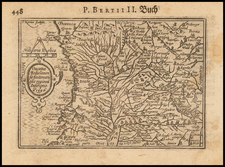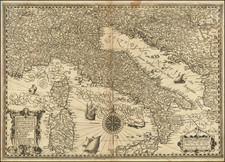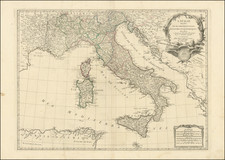Spectacular 12-sheet map of Italy, first published by Matteo Greuter in Rome in 1630.
Matteo Greuter was born in Strasbourg in 1566, where he was trained as engraver. He later worked in Lyon and Avignon, before settling in Rome around 1610. He distinguished himself by his extremely accurate and elegant technique, engraving numerous religious and mythological objects
Greuter is perhaps best known as a maker of fine globes. Stevenson notes that Greuter "is entitled to rank with the leading globemakers of the Netherlands". Greuter also published several fine wall maps, including a plan of Rome in 1618, another of Mantua in 1629, and this remarkable 12 sheet map of Italy 1630.
The longitudes shown are relative to the Cape Verde islands. The place names are in Italian and the map contains allegorical figures from various regions of Italy. The three major islands of Sicily, Sardinia and Corsica are shown separately.
A curious feature of this map is Greuter's decision to arrange Italy horizontally. His reasons are explained in the scroll ornament on the map itself.
Greuter's map of Italy proved so popular that it was reissued several times. First, in Venice by Stefano Scolari in 1657; then by PietroTedeschi and Giuseppe Longhi, Bologna, 1676; and then by Domenico De Rossi, Rome, in 1695. The present example would appear to be a later unrecorded example issued by Tedeschi and Longhi in 1713.
Matteo Greuter
Not a great deal is known about Matthaus Greuter. He published many religious and mythological scenes and is recognized for his elegant engraving style. Perhaps his most spectacular production was his twelve-sheet map of Italy, considered one of the finest ever produced of the country.
Stevenson ( Terrestrial and Celestial Globes) notes that he was born in Strassbourg, but spent his earlier years working in Lyon and Avignon. He appears to have settled in Rome some time before 1632 (the date of his earliest globe) and the excellence of his engraving skills achieved him great recognition and standing amongst his fellow Italian artists.
Greuter started globe making relatively late in his career and if we accept his date of birth as 1566, his first globe was published when he was 66 years old. This 50cm globe was of such high standard that Stevenson was prompted to write "So well did he perform his work that he is entitled to rank with the leading globe makers of the Netherlands". Certainly Greuter was strongly influenced by his Dutch counterparts especially Willem Blaeu, whose globes Greuter copied. Stevenson notes that during the last six years of his life, Greuter went on to produce a 1636 celestial globe and a 1636 re-issue of his 1632 terrestrial globe. Then in 1638, Giovanni Battista Rossi released what Stevenson refers to as a "second edition of his globes of the years 1632 and 1636". Both globes were the same dimension as Greuter's earlier globes and both were dated 1636.
Following Greuter's death in 1638, his globes were published firstly by Giovanni Battista de Rossi and later by another Rossi family member, Domenico de Rossi, a number of which are detailed in Elly Dekker's book Globes at Greenwich and Stephenson's Terrestrial and Celestial Globes.
Matteo, or Matthaus, Greuter published many religious and mythological scenes and is recognized for his elegant engraving style. Perhaps his most spectacular production was his twelve-sheet map of Italy, considered one of the finest ever produced of the country. He also produced other maps, though, including a plan of Rome (1619) and a plan of Mantua (1629). In addition to prints, plans, and maps, he is known to have engraved several globes.
A Catholic, Greuter was born in Strassbourg, but spent his earlier years working in Lyon and Avignon. Then, he struck out for Rome, where he began engraving a variety of works, including plans and maps, by 1606. He produced for a variety of patrons, including Cardinal Scipione Boghese, Pope Paul V, the Accademia dei Lincei, and Pope Urban VIII. He also made the etchings for Galileo’s Macchie Solari [Letters on Sunspots] (1613), for which he developed a new copperplate etching technique.
As for globes, his first globe map is dated 1632. Greuter started globe making relatively late in his career; his first globe was published when he was nearly 70 years old. This 50cm globe was of such a high standard that globe expert Edward Luther Stevenson was prompted to write, "So well did he perform his work that he is entitled to rank with the leading globe makers of the Netherlands."
Greuter was strongly influenced by his Dutch counterparts, especially Willem Blaeu, whose globes Greuter updated. Stevenson notes that during the last years of his life, Greuter went on to produce a 1635 celestial globe and several reduced-size globes. Following Greuter’s death in 1638, Giovanni Battista Rossi and, later, Domenico de Rossi, released subsequent Greuter globes. A number of these are detailed in Elly Dekker's book Globes at Greenwich and Stephenson's Terrestrial and Celestial Globes.













![Plan Des [Ersten?] und Lezten Theil Der Affeire Des Feldmarschal Konigseg in Tyrol](https://storage.googleapis.com/raremaps/img/small/51959.jpg)
![[Whoever is silent is Complicit -- Anti-Vietnam / Anti-American Poster] Vietnam: Sterminio | chi tace è complice](https://storage.googleapis.com/raremaps/img/small/89365.jpg)